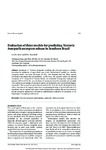Please use this identifier to cite or link to this item:
http://www.alice.cnptia.embrapa.br/alice/handle/doc/992548| Title: | Evaluation of three models for predicting Venturia inaequalis ascospore release in Southern Brazil. |
| Authors: | ALVES, S. A. M.  BERESFORD, R. M.   |
| Affiliation: | SILVIO ANDRE MEIRELLES ALVES, CNPUV; R.M. Beresford. |
| Date Issued: | 2013 |
| Citation: | New Zealand Plant Protection, v. 66, p. 303-307, 2013. |
| Pages: | 5 p. |
| Description: | Ascospores of Venturia inaequalis constitute the principal source of primary inoculum for epidemics of apple black spot (scab). Mathematical models that describe ascospore release have been developed in USA, New Zealand and Italy. These models are based upon degree-day accumulation. In this work, the seasonal pattern of released ascospores of V. inaequalis in Vacaria, Brazil, was evaluated. During four apple growth seasons (2009 to 2012) the natural release of ascospores from ive orchards was recorded. The cumulative percentage of ascospore release was predicted using three different degreeday models. The released ascospore data showed the best it to the model developed in Italy, with a start date of 22 August rather than the phenological stage of apple bud break. It is concluded that in regions with warm winter temperatures, models that use bud break to initiate ascospore maturation will tend to underestimate availability of ascospores at the beginning of the apple growth season. |
| Thesagro: | Maçã Epidemiologia Malus Domestica Venturia Inaequalis |
| Keywords: | Ascosporo |
| Type of Material: | Artigo de periódico |
| Access: | openAccess |
| Appears in Collections: | Artigo em periódico indexado (CNPUV)  |
Files in This Item:
| File | Description | Size | Format | |
|---|---|---|---|---|
| nzpp663030.pdf | 145.01 kB | Adobe PDF |  View/Open |









